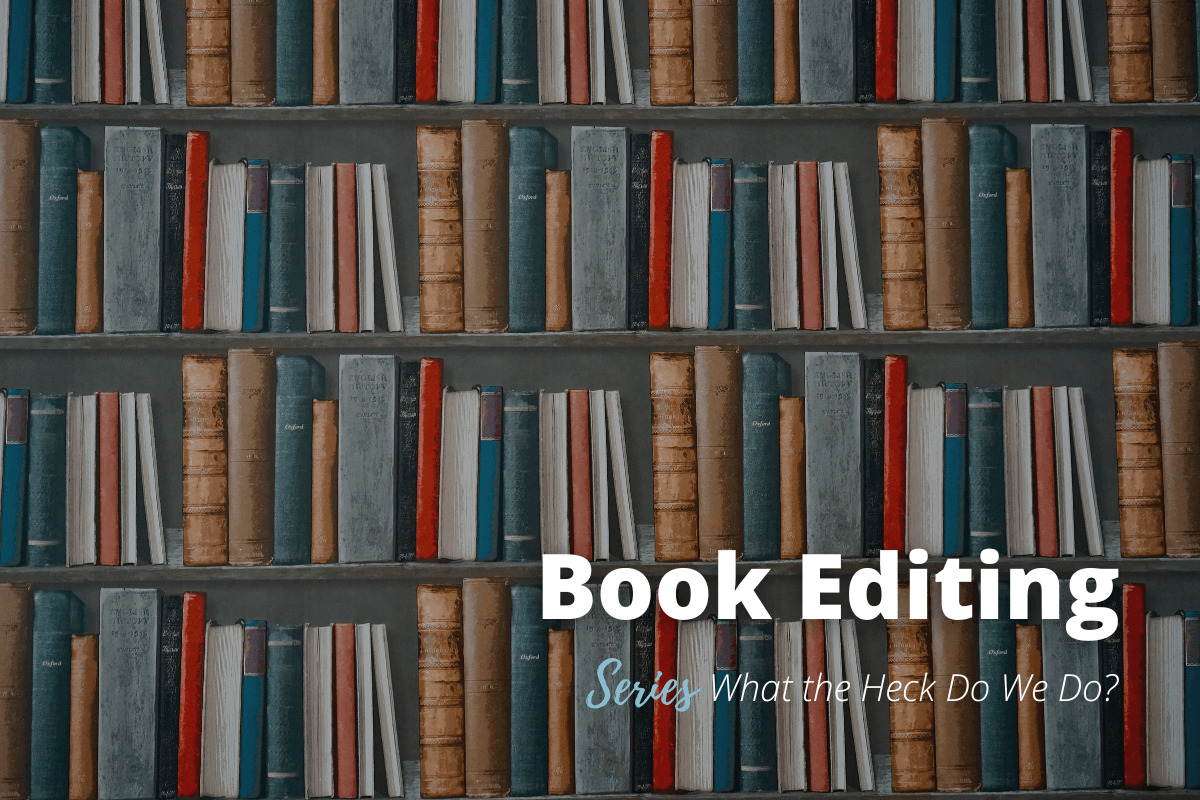Sculpting a Story: What the Heck Is Book Editing?

This post is a part of our services overview series, “What the Heck Do We Do?”.
As writers and editors, we understand how brain-draining drafting a story can be. You have to stick to the conventions of your genre, create relatable characters with rich backstories (while avoiding info-dumps), insert conflict and resolution at appropriate times, write realistic yet plot-propulsive dialogue, and then wrap it all up with a satisfying, cohesive conclusion. Or maybe you’re the type to draft in pure chaos and worry about incorporating all the principles of writing craft later, during the alchemy of editing.
Some writers prefer to make a detailed outline to ensure all plot beats are hit and the story has legs before any words splash the page, while others can’t possibly create under such restrictive conditions and need to jump head-first into the flow state of discovery drafting. Personally, we like to strike a balance between the two.
Regardless of how you arrive at a complete first draft, revising and editing need to be just as important in every writer’s process. You’ll never get it right on the first try. And that’s okay — you aren’t supposed to. Even Stephen King needs to go through several editing rounds, which he details in his insightful book, On Writing: A Memoir of the Craft.
If the thought of having to edit, or even — gasp — rewrite your entire manuscript fills you with gut-wrenching dread, you’re not alone. Drafting is a particular superpower some writers possess; it just comes naturally, like those who are inherently gifted when it comes to hand-eye coordination or solving complex mathematical problems (two things that will always boggle my brain). However, revising and editing are often where the real magic happens — where the heart of the story is unearthed and the plot strings tie together.
It seems writers often identify as one or the other: drafting dynamos, or eager editors. For those in the former category, who find the editing process to be frightfully dull, overwhelming, or agonizing, or simply don’t have the time to tackle it, our book editors can sweep your manuscript off its feet. We’ll finely tune, tweak, and finesse your words until the finished product is a thing of bookish beauty and ready for publication. Or at least ready to query literary agents with, which we tackle in another post.
But What the Heck is Involved in Book Editing?
We’re so glad you asked! Because the answer isn’t as obvious as you may think. It’s important to make the distinction between different types of book editing to identify which you require: Developmental/Substantive/Structural Editing, Stylistic Editing, Copy Editing, and Proofreading. Some may want it all, while others may only need one or two.
So let’s break it down:
- Developmental/Substantive/Structural Editing requires an analysis of the story shape as a whole — a review of the entire manuscript from a big-picture perspective to ensure no plot hole goes unfilled. A substantive edit will address some major questions:
- Is your story sticking to its genre conventions? E.g., a romcom needs a happily ever after, a thriller needs page-turning tension from the get-go, a horror needs life-or-death stakes, etc. Every story needs to include genre-specific elements in order to categorize it as such, which is why most editors specialize in the genres they have studied and enjoy most. The same goes for age categories: Adult, Young Adult, Middle Grade, Chapter Books, Early Readers. If you’re unsure where your manuscript fits, our team of book editors can help you identify your genre and age category through the editing process.
- Does your story have consistent structure and pacing? Every story is unique, but each one needs to follow an overall beat structure in order to achieve cohesion and leave readers feeling satisfied from beginning to end. We like to use Save the Cat! Writes a Novel by Jessica Brody as a basic guide for how all stories should be structured, regardless of genre. This can be applied to unconventional plot structures as well: epistolary elements, reverse chronology, jumping timelines, and multi-POVs, just to name a few.
- Is your narrative voice and point-of-view (POV) consistent? Narrative voice is so tricky to describe, and keeping it consistent throughout an entire story is even more difficult, especially as your protagonist evolves. Because of its nebulous nature (and how hard it can be for writers to identify issues in their own stories due to being too close to the material), it can be incredibly helpful to have a substantive editor go through your words with a fine-toothed comb to ensure your narrative voice stays on track. For example, if your protagonist is a snarky teenager told from first-person POV (using I instead of she/he/they), an editor will make sure they consistently sound like a snarky teen and stay in first-person, especially during internal dialogue.
- Stylistic Editing focuses specifically on language, clarity, sentence and paragraph structure, and overall word flow. This type of edit should only be done after you’ve gone through a substantive edit. A skilled stylistic editor will tighten up your prose, suggest alternative wording to help clarify meaning or strengthen verb choice, and slash redundancies and confusion, all while honouring your authorial voice. An author’s voice should never be compromised, and we always prioritize this during any type of edit.
- Copy Editing focuses on the nitty gritty of your manuscript on a line level, requiring a sharp, detail-oriented editorial eye. We’re talking about those pesky grammar, punctuation, spelling, syntax, accuracy, and consistency issues. We also understand when the strict rules governing copy should be broken! Sometimes exceptions need to be made when it comes to dialogue and narrative voice; experienced copy editors know how and when to identify these exceptions. Copy edits often require the use of a style sheet to keep track of editorial style and ensure it’s applied consistently and correctly throughout.
- Proofreading is the final step in the editorial process. Congratulations! You’ve made it this far, so why not take it all the way? Proofreading is that last stretch before sliding into home plate; it’s your final sprint after making a circuit of all three preceding bases. (Yes, I just mocked my hand-eye coordination and then wrote an editing-as-baseball metaphor. I contain multitudes.) It involves a final sweep of your manuscript to catch anything that may have slipped through the cracks. This includes checking for errors, omissions, missing pages, and formatting inconsistencies, and ensuring the manuscript adheres to the style sheet.
How Can We Help?
First of all, we’d like to applaud you for completing a story draft. It’s a massive undertaking and accomplishment for any writer, so bravo! If you’re stuck at the drafting stage, even after letting the story breathe like an uncorked bottle of rosé for two weeks or longer (sommelier’s note: this timeline does not apply to the wine, of course!), we’d be thrilled to help you navigate the editorial process.
Because we understand how personal your story is to you, we’ll start by getting to know you, your vision, and what you hope to gain by hiring a book editor through a consultation. To make sure we’re on the same page and that our editorial style aligns with yours, we will also provide a free sample edit. From there, the magic will begin!
Regardless of which type of editing you require, we take a collaborative approach to each project, consulting you every step of the way. It’s a partnership, not a hostile takeover. We use suggestive edits, which means you have the final say to accept or reject anything we recommend. After all, this is your story, your vision, and it’s vital to us that your authorial voice is respected and maintained throughout the entire process.
In terms of genre, we are interested in working on a wide variety of fiction and non-fiction projects for adult, young adult, and middle grade readers. Genres we’d love to see include, but are not limited to, horror, thriller, fantasy, science-fiction, contemporary, women’s fiction, historical, and memoir.
We know how to sculpt stories thanks to years of study and craft-building. Your book will be publication or query-ready by the time we’re finished with it — all you have to do is get in touch, and we’ll take your draft from scrappy to polished.

